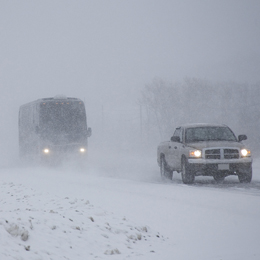 Every winter, we see stories on multiple-car pileups. While many of us have lived in a snowy climate our whole lives, many people forget the skills and level of caution needed to drive in adverse winter conditions.
Every winter, we see stories on multiple-car pileups. While many of us have lived in a snowy climate our whole lives, many people forget the skills and level of caution needed to drive in adverse winter conditions.
Here are some reminders that will help keep you and your family safe when traveling this winter season.
1. Be aware of changing weather conditions. If you don’t need to go out in a snowstorm, don’t. If you do need to travel, use technology to your advantage. Many weather apps for Smartphones provide up-to-date weather conditions and send severe weather alerts to your phone.
2. Stay in your car if you’re involved in an accident. While it may be instinctual to get out of your car and survey the damage, don’t. It’s safer to remain in your vehicle. From your car, you can call your family, police, insurance company, or a tow truck. If you’re in a pileup and can safely get your vehicle off the roadway, do it. If you can’t and are in the driver’s seat with more cars coming your way, try and slide into the passenger seat and put on your seatbelt.
3. Pay attention to road conditions and what’s happening in front of you. The link below provides live camera footage from a Wisconsin Department of Motor Vehicle’s traffic cam. As you watch the video, you’ll see that traffic is moving slowly and the approaching cars are traveling too fast for the conditions. You can learn a lot by watching this video. It’s pretty incredible. Wisconsin pileup
4. If you’re approaching an accident or the road is in poor condition, turn on your hazard lights. This immediately alerts people behind you that a potentially dangerous situation exists and that they should begin to slow down.
5. Avoid using cruise control when driving in rain or snow. The slippery surface can cause your tires to slip, putting your car into an out-of-control spin.
6. Keep a safe following distance. Experts recommend keeping a safe following distance of eight to ten seconds. A car traveling at 60mph covers 88 feet per second, so it can take a vehicle traveling on wet or snow-covered roads 6 to 10 seconds and more than 500 feet to stop.
To learn more about the coverage your insurance provides after a multi-car accident, click on the article from R&R Insurance titled “Multi-Car Crashes: Who’s Responsible and How to Stay Safe If You’re In One.”
Do you have any suggestions or information you’d like to share? I’d love to hear from you. Please share them in the box below.





